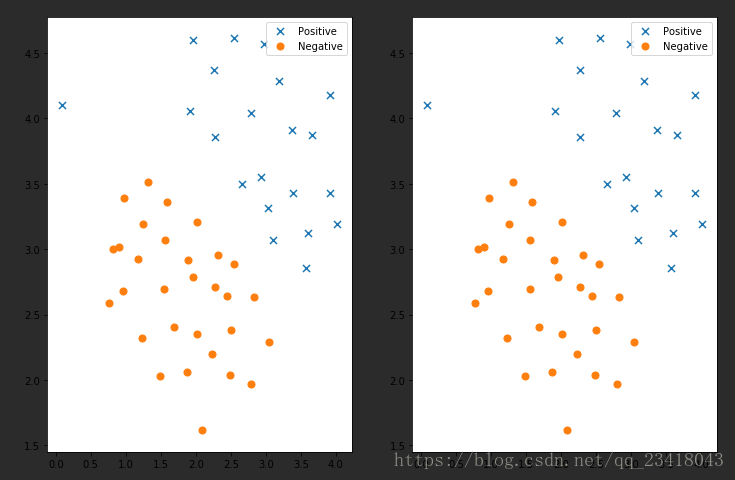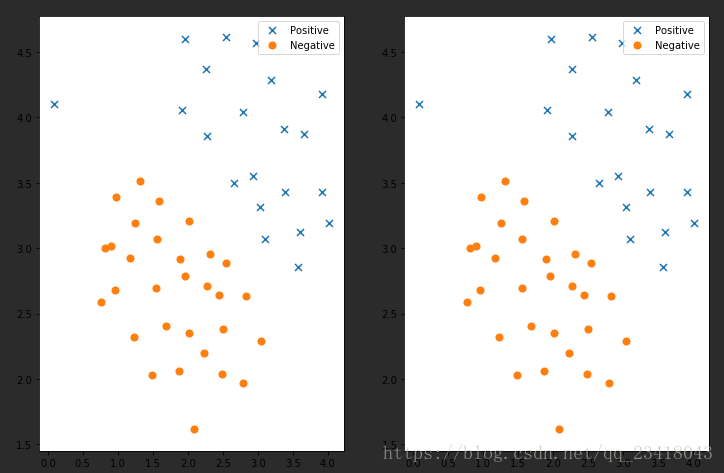- ubuntu12.04环境下使用kvm ioctl接口实现最简单的虚拟机
- Ubuntu 通过无线网络安装Ubuntu Server启动系统后连接无线网络的方法
- 在Ubuntu上搭建网桥的方法
- ubuntu 虚拟机上网方式及相关配置详解
CFSDN坚持开源创造价值,我们致力于搭建一个资源共享平台,让每一个IT人在这里找到属于你的精彩世界.
这篇CFSDN的博客文章Matplotlib实现subplot和subplots简单对比由作者收集整理,如果你对这篇文章有兴趣,记得点赞哟.
大家一般都知道subplot可以画子图,但是subplots也可以画子图,鉴于subplots介绍比较少,这里做一个对比,两者没有功能一致.
需求:画出两张子图,在一行显示,子图中的内容一模一样 。
subplot代码:
ax1 = plt.subplot(1,2,1)ax1.scatter(positive["X1"], positive["X2"], s=50, marker="x", label="Positive")ax1.scatter(negative["X1"], negative["X2"], s=50, marker="o", label="Negative")ax1.legend()#添加图列就是右上角的点说明ax2 = plt.subplot(1,2,2)ax2.scatter(positive["X1"], positive["X2"], s=50, marker="x", label="Positive")ax2.scatter(negative["X1"], negative["X2"], s=50, marker="o", label="Negative")ax2.legend()#添加图列就是右上角的点说明

subplots代码:
fig, ax = plt.subplots(figsize=(12,8),ncols=2,nrows=1)#该方法会返回画图对象和坐标对象ax,figsize是设置子图长宽(1200,800)ax[0].scatter(positive["X1"], positive["X2"], s=50, marker="x", label="Positive")ax[0].scatter(negative["X1"], negative["X2"], s=50, marker="o", label="Negative")ax[0].legend()#添加图列就是右上角的点说明ax[1].scatter(positive["X1"], positive["X2"], s=50, marker="x", label="Positive")ax[1].scatter(negative["X1"], negative["X2"], s=50, marker="o", label="Negative")ax[1].legend()#添加图列就是右上角的点说明

可以看出来两者都可以实现画子图功能,只不过subplots帮我们把画板规划好了,返回一个坐标数组对象,而subplot每次只能返回一个坐标对象,subplots可以直接指定画板的大小.
参考博客:Matplotlib的子图subplot的使用 。
参考博客:subplots与figure函数参数解释说明以及简单的使用脚本实例 。
到此这篇关于Matplotlib实现subplot和subplots简单对比的文章就介绍到这了,更多相关Matplotlib subplot和subplots内容请搜索我以前的文章或继续浏览下面的相关文章希望大家以后多多支持我! 。
原文链接:https://blog.csdn.net/qq_23418043/article/details/81813903 。
最后此篇关于Matplotlib实现subplot和subplots简单对比的文章就讲到这里了,如果你想了解更多关于Matplotlib实现subplot和subplots简单对比的内容请搜索CFSDN的文章或继续浏览相关文章,希望大家以后支持我的博客! 。
我有点不清楚如何subplot作品。具体来说subplot(121)有什么区别和 subplot(1,2,1)在 MATLAB 中?我试图搜索 subplot文档,但我似乎找不到我要找的东西。 最佳答
我是编码方面的新手,因此也是 Python 方面的新手,所以这听起来可能很愚蠢,但是 Python 中 matplotlib 的 .subplot() 和 .subplots() 方法之间的主要区别是
def plot_it(U1, U2, x, i): fig_1, = plt.plot(x, U1) fig_2, = plt.plot(x, U2) i = str(int
有时候想要把几张图放在一起plot,比较好对比,subplot和subplots都可以实现,具体对比可以查看参考博文。这里用matplotlib库的subplot来举个栗子。 数据长什么样 有两
在matplotlib中,用subplots画子图时,有时候需要调整子图间矩,包括子图与边框的间矩,子图间上下间矩,子图间左右间矩,可以使用fig.tight_layout()函数:
如下所示: matplotlib subplots 设置总图的标题 : fig.suptitle(dname,fontsize=16,x=0.53,y=1.05,) 以上这篇matplotli
我不知道如何使用 R 和 Plotly 使表格子图正常工作。 下面演示了我的意思。我有两张图,一张散点图和一张 table 。使用 subplot 函数,表格图的行为不符合预期。 我要么在散点图上失去
我正在尝试绘制一些子图,但似乎无法共享轴。我看过其他代码,他们似乎完全按照我的尝试做,但我的似乎没有做任何事情。 我只是想在左侧的四个子图中共享各自的轴,同时将最右侧的子图分开。 import num
我想在子图的底部添加一个图例(2 x 2): 正如您所看到的,由于我手动调整了第二行中的图表,因此被挤压了一点。 是否有像 sublegend(...) 这样的函数,或者它是否涉及大量编码? 来源 这
在使用 Matplotlib 绘图时,我们大多数情况下,需要将一张画布划分为若干个子区域,之后,我们就可以在这些区域上绘制不用的图形。在本节,我们将学习如何在同一画布上绘制多个子图。 matplotl
matplotlib.pyplot模块提供了一个 subplots() 函数,它的使用方法和 subplot() 函数类似。其不同之处在于,subplots() 既创建了一个包含子图区域的画布,又创建
使用 plotly 的 subplots() 时,如何删除图例中的重复项? 这是我的 MWE: library(plotly) library(ggplot2) library(tidyr) mpg
如何调整某些子图之间的空白?在下面的示例中,假设我想消除第 1 个和第 2 个子图之间以及第 3 个和第 4 个之间的所有空白,并增加第 2 个和第 3 个之间的空间? import matplotl
如果我绘制如下所示的单个图表,其大小将为 (x * y)。 import matplotlib.pyplot as plt plt.plot([1, 2], [1, 2]) 但是,如果我在同一行中绘制
我需要在网格中显示20张图像,我的代码如下 def plot_matric_demo(img, nrows, ncols): fig, ax = plt.subplots(nrows=nrow
这个问题在这里已经有了答案: How to plot in multiple subplots (12 个答案) 关闭去年。 我在一些帮助下构建了一组饼图 Insert image into pie
我正在寻找一种方法来创建一个包含多个子图的绘图 fig, (ax0, ax1) = plt.subplots(nrows=2, sharex=True) 会在 matplotlib 中执行,然后可以通
当我使用 PyPlot 的 figure() 函数创建单个绘图时,我可以使用字符串作为参数来设置出现窗口的名称: import matplotlib.pyplot as plt figure = pl
我想要一个由四个子图组成的图形。其中两个是通常的线图,其中两个是 imshow-images。 我可以将 imshow-images 格式化为正确的绘图本身,因为它们中的每一个都需要自己的颜色条、修改
我在使用 plt.subplots 时尝试更改图形大小时遇到了一些麻烦。使用下面的代码,我只得到标准尺寸的图表,其中包含我所有的子图(大约有 100 个),并且显然只是一个额外的空 figures

我是一名优秀的程序员,十分优秀!